Correlation of Impedance Matching and Optical Emission Spectroscopy during Plasma-Enhanced Chemical Vapor Deposition of Nanocrystalline Silicon Thin Films
Abstract
1. Introduction
2. Experimental
2.1. Film Preparation
2.2. Film Characterization
3. Results and Discussion
3.1. Optical Emission Spectra Spectroscopy Analysis
3.2. Transmission Electron Microscopy
3.3. Quadruple Mass Spectra
3.4. Hydrogen Dilution Ratio Impact on the Matching Network
4. Conclusions
Author Contributions
Funding
Acknowledgments
Conflicts of Interest
References
- Kitao, J.; Harada, H.; Yoshida, N.; Kasuya, Y.; Nishio, M.; Sakamoto, T.; Itoh, T.; Nonomura, S.; Nitta, S. Absorption coefficient spectra of μc-Si in the low-energy region 0.4–1.2 eV. Sol. Energy Mater. Sol. Cells 2001, 66, 245–251. [Google Scholar] [CrossRef]
- Shah, A.V.; Meier, J.; Vallat-Sauvain, E.; Wyrsch, N.; Kroll, U.; Droz, C.; Graf, U. Material and solar cell research in microcrystalline silicon. Sol. Energy Mater. Sol. Cells 2003, 78, 469–491. [Google Scholar] [CrossRef]
- Ito, M.; Koch, C.; Svrcek, V.; Schubert, M.B.; Werne, J.H. Silicon thin film solar cells deposited under 80 °C. Thin Solid Films 2001, 383, 129–131. [Google Scholar] [CrossRef]
- Guha, S.; Yang, J.; Yan, B. High efficiency multi-junction thin film silicon cells incorporating nanocrystalline silicon. Sol. Energy Mater. Sol. Cells 2013, 119, 1–11. [Google Scholar] [CrossRef]
- Green, M.A.; Emery, K.; Hishikawa, Y.; Warta, W.; Dunlop, E.D. Solar cell efficiency tables (version 46). Prog. Photovolt. Res. Appl. 2015, 23, 805–812. [Google Scholar] [CrossRef]
- Vallat-Sauvain, E.; Kroll, U.; Meier, J.; Shah, A. Evolution of the microstructure in microcrystalline silicon prepared by very high frequency glow-discharge using hydrogen dilution. J. Appl. Phys. 2000, 87, 3137. [Google Scholar] [CrossRef]
- Li, S.B.; Wu, Z.M.; Jiang, Y.D.; Li, W.; Liao, N.M.; Yu, J.S. Structure and 1/f noise of boron doped polymorphous silicon films. Nanotechnology 2008, 19, 085706. [Google Scholar] [CrossRef]
- Das, U.K.; Chaudhuri, P.; Kshirsagar, S.T. Effect of argon dilution on the structure of microcrystalline silicon deposited from silane. J. Appl. Phys. 1996, 80, 5389. [Google Scholar] [CrossRef]
- Das, D. Structural studies on Si:H network by Raman, micro-photoluminescence, electron microscopy and ultraviolet ellipsometry: Effect of Ar dilution to the SiH4-plasma. Thin Solid Films 2005, 476, 237–245. [Google Scholar] [CrossRef]
- Gope, J.; Kumar, S.; Singh, S.; Rauthan, C.M.S.; Srivastava, P.C. Growth of mixed-phase amorphous and ultra nanocrystalline silicon thin films in the low pressure regime by a VHF PECVD process. Silicon 2012, 4, 127–135. [Google Scholar] [CrossRef]
- Parashar, A.; Kumar, S.; Gope, J.; Rauthan, C.M.S.; Hashmi, S.A.; Dixit, P.N. RF power density dependent phase formation in hydrogenated silicon films. J. Non-Cryst. Solids 2010, 356, 1774–1778. [Google Scholar] [CrossRef]
- Gope, J.; Kumar, S.; Sudhakar, S.; Lodhi, K.; Rauthan, C.M.S.; Srivastava, P.C. Influence of argon dilution on the growth of amorphous to ultra nanocrystalline silicon films using VHF PECVD process. J. Alloy. Compd. 2013, 577, 710–716. [Google Scholar] [CrossRef]
- Hadjadj, A.; Beorchia, A.; Cabarrocas, P.R.; Boufendi, L.; Huet, S.; Bubendorff, J.L. Effects of the substrate temperature on the growth and properties of hydrogenated nanostructured silicon thin films. J. Phys. D Appl. Phys. 2001, 34, 690. [Google Scholar] [CrossRef]
- Hsieh, Y.L.; Kau, L.H.; Huang, H.J.; Lee, C.C.; Fuh, Y.K.; Li, T.T. In Situ plasma monitoring of PECVD nc-Si:H Films and the influence of dilution ratio on structural evolution. Coatings 2018, 8, 238. [Google Scholar] [CrossRef]
- Luysberg, M.; Hapke, P.; Carius, R.; Finger, F. Structure and growth of hydrogenated microcrystalline silicon: Investigation by transmission electron microscopy and Raman spectroscopy of films grown at different plasma excitation frequencies. Philos. Mag. A 1997, 75, 31–47. [Google Scholar] [CrossRef]
- Chowdhury, A.; Mukhopadhyay, S.; Ray, S. Effect of electrode separation on PECVD deposited nanocrystalline silicon thin film and solar cell properties. Sol. Energy Mater. Sol. Cells 2010, 94, 1522–1527. [Google Scholar] [CrossRef]
- Donne, A.L.; Binetti, S.; Isella, G.; Pichaud, B.; Texier, M.; Acciarri, M.; Pizzini, S. Structural characterization of nc-Si films grown by low-energy PECVD on different substrates. Appl. Surf. Sci. 2008, 254, 2804–2808. [Google Scholar] [CrossRef]
- Koirala, S.P.; Abu-Safe, H.H.; Mensah, S.L.; Naseem, H.A.; Gordon, M.H. Langmuir probe and optical emission studies in a radio frequency (rf) magnetron plasma used for the deposition of hydrogenated amorphous silicon. Surf. Coat. Technol. 2008, 203, 602–605. [Google Scholar] [CrossRef]
- Oda, S.; Noda, J.; Matsumura, M. Diagnostic study of VHF plasma and deposition of hydrogenated amorphous silicon films. Jpn. J. Appl. Phys. 1990, 29, 1889. [Google Scholar] [CrossRef]
- Sahu, B.B.; Han, J.G.; Shin, K.S.; Ishikawa, K.; Hori, M.; Miyawaki, Y. Plasma diagnostic approach for high rate nanocrystalline Si synthesis in RF/UHF hybrid plasmas using a PECVD process. Plasma Sources Sci. Technol. 2015, 24, 025019. [Google Scholar] [CrossRef]
- Cristophorou, L.G.; Olthoff, J.K. Fundamental electron-molecule interactions and their technological significance. In Fundamental Electron Interactions with Plasma Processing Gases; Springer: Boston, MA, USA, 2004; pp. 1–59. [Google Scholar]
- Kummer, M.; Rosenblad, C.; Dommann, A.; Hackbarth, T.; Höck, G.; Zeuner, M.; Muller, E.; Kanel, H. Low energy plasma enhanced chemical vapor deposition. Sci. Eng. B 2002, 89, 288–295. [Google Scholar] [CrossRef]
- Ferrara, M.A.; Donato, M.G.; Sirleto, L.; Messina, G.; Santangelo, S.; Rendina, I. Study of strain and wetting phenomena in porous silicon by Raman scattering. J. Raman Spectrosc. 2008, 39, 199–204. [Google Scholar] [CrossRef]
- Lee, N.; Hartschuh, R.D.; Mehtani, D.; Kisliuk, A.; Maguire, J.F.; Green, M.; Foster, M.D.; Sokolov, A.P. High contrast scanning nano-Raman spectroscopy of silicon. J. Raman Spectrosc. 2007, 38, 789–796. [Google Scholar] [CrossRef]
- Ehbrecht, M.; Kohn, B.; Huisken, F.; Laguna, M.A.; Paillard, V. Photoluminescence and resonant Raman spectra of silicon films produced by size-selected cluster beam deposition. Phys. Rev. B 1997, 56, 6958. [Google Scholar] [CrossRef]
- Hu, Z.; Liao, X.; Diao, H.; Cai, Y.; Zhang, S.; Fortunato, E.; Martins, R. Hydrogenated p-type nanocrystalline silicon in amorphous silicon solar cells. J. Non-Cryst. Solids 2006, 352, 1900–1903. [Google Scholar] [CrossRef]
- Li, Z.; Li, W.; Jiang, Y.; Cai, H.; Gong, Y.; He, J. Raman characterization of the structural evolution in amorphous and partially nanocrystalline hydrogenated silicon thin films prepared by PECVD. J. Raman Spectrosc. 2011, 42, 415–421. [Google Scholar] [CrossRef]
- Kroll, U.; Shah, A.; Keppner, H.; Meier, J.; Torres, P.; Fischer, D. Potential of VHF-plasmas for low-cost production of a-Si:H solar cells. Sol. Energy Mater. Sol. Cells 1997, 48, 343–350. [Google Scholar] [CrossRef]
- Smith, P.H. Transmission line calculator. Electronics 1939, 12, 29–31. [Google Scholar]
- Malherbe, J.A.G. The locus of points of constant VSWR when renormalized to a different characteristic impedance. IEEE Trans. Microw. Theory Tech. 1977, 25, 444–445. [Google Scholar] [CrossRef]
- Kurokawa, K. Power waves and the scattering matrix. IEEE Trans. Microw. Theory Tech. 1965, 13, 194–202. [Google Scholar] [CrossRef]
- Hsieh, Y.L.; Tseng, C.L.; Lee, C.C.; Fuh, Y.K.; Chang, J.Y.; Lee, J.Y.; Li, T.T. Improved process stability on an extremely thin amorphous/crystalline silicon interface passivation layer by using predeposition on the chamber wall. ECS J. Solid State Sci. Technol. 2018, 7, 355–361. [Google Scholar] [CrossRef]
- Hsieh, Y.L.; Kau, L.H.; Huang, H.J.; Lee, C.C.; Fuh, Y.K.; Li, T.T. In-situ plasma monitoring of PECVD a-Si:H (i)/a-Si:H (n) surface passivation for heterojunction solar cells application. In Proceedings of the 2018 China Semiconductor Technology International Conference (CSTIC), Shanghai, China, 11–12 March 2018. [Google Scholar]
- Kirner, S.; Gabriel, O.; Stannowski, B.; Rech, B.; Schlatmann, R. The growth of microcrystalline silicon oxide thin films studied by in situ plasma diagnostics. Appl. Phys. Lett. 2013, 102, 051906. [Google Scholar] [CrossRef]
- Chaudhary, D.; Sharma, M.; Sudhakar, S.; Kumar, S. Investigation of powder dynamics in silane-argon discharge using impedance analyser. Phys. Plasmas 2016, 23, 123704. [Google Scholar] [CrossRef]
- He, Y.; Yin, C.; Cheng, G.; Wang, L.; Liu, X.; Hu, G.Y. The structure and properties of nanosize crystalline silicon films. J. Appl. Phys. 1994, 75, 797. [Google Scholar] [CrossRef]
- Kondo, M.; Fukawa, M.; Guo, L.; Matsuda, A. High rate growth of microcrystalline silicon at low temperatures. J. Non-Cryst. Solids 2000, 266–269, 84–89. [Google Scholar] [CrossRef]
- Strahm, B.; Howling, A.A.; Sansonnens, L.; Hollenstein, C. Optimization of the microcrystalline silicon deposition efficiency. J. Vac. Sci. Technol. A 2007, 25, 1198. [Google Scholar] [CrossRef]
- Bastami, A.A.; Jurkov, A.; Gould, P.; Hsing, M.; Schmidt, M.; Ha, J.-I.; Perreault, D.J. Dynamic matching system for radio-frequency plasma generation. IEEE Trans. Power Electron. 2018, 33, 1940–1951. [Google Scholar] [CrossRef]
- Chaudhary, D.; Sharma, M.; Sudhaka, S.; Kuma, S. Effect of pressure on bonding environment and carrier transport of a-Si:H thin films deposited using 27.12 MHz assisted PECVD process. Silicon 2018, 10, 91–97. [Google Scholar] [CrossRef]
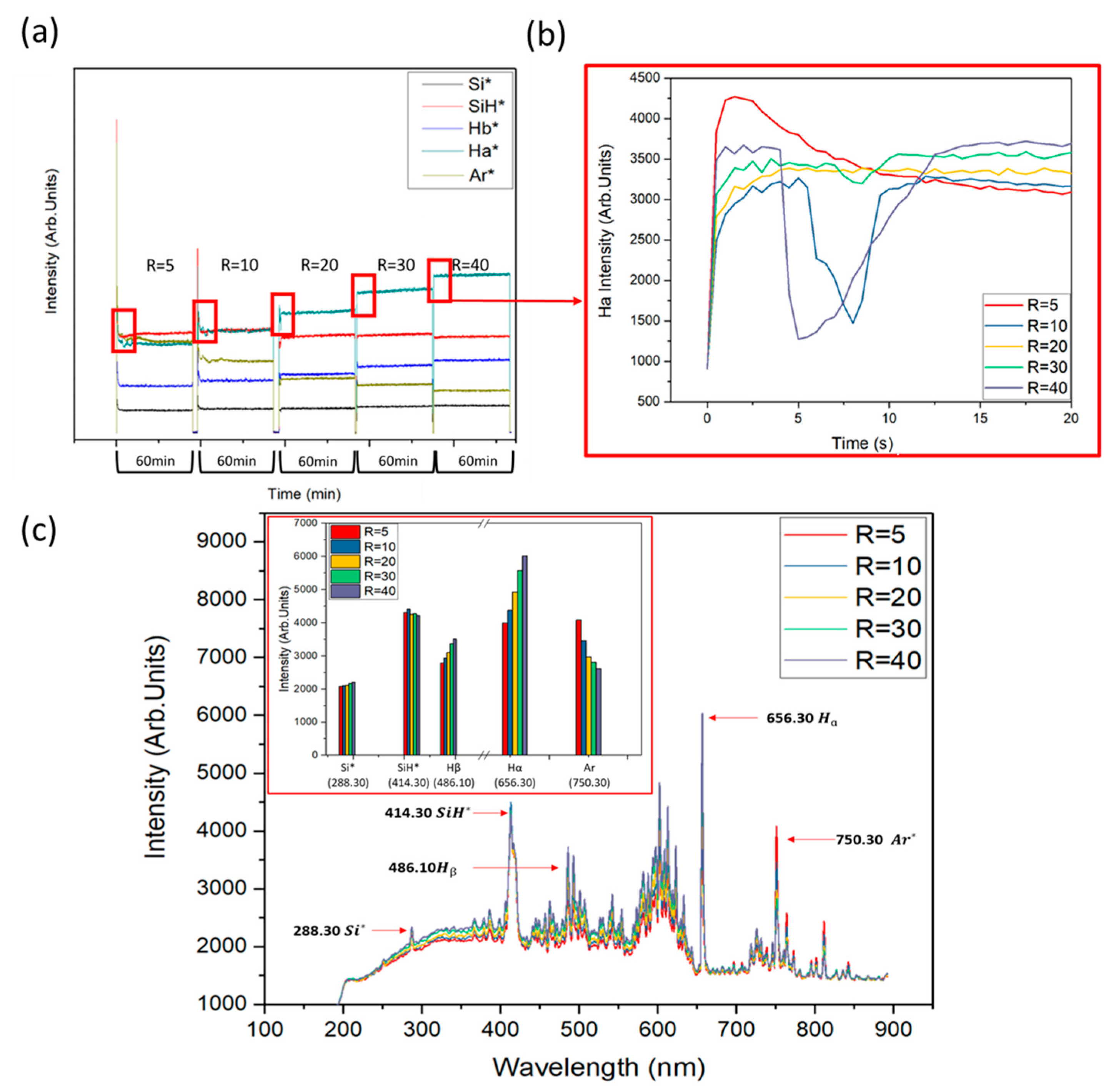
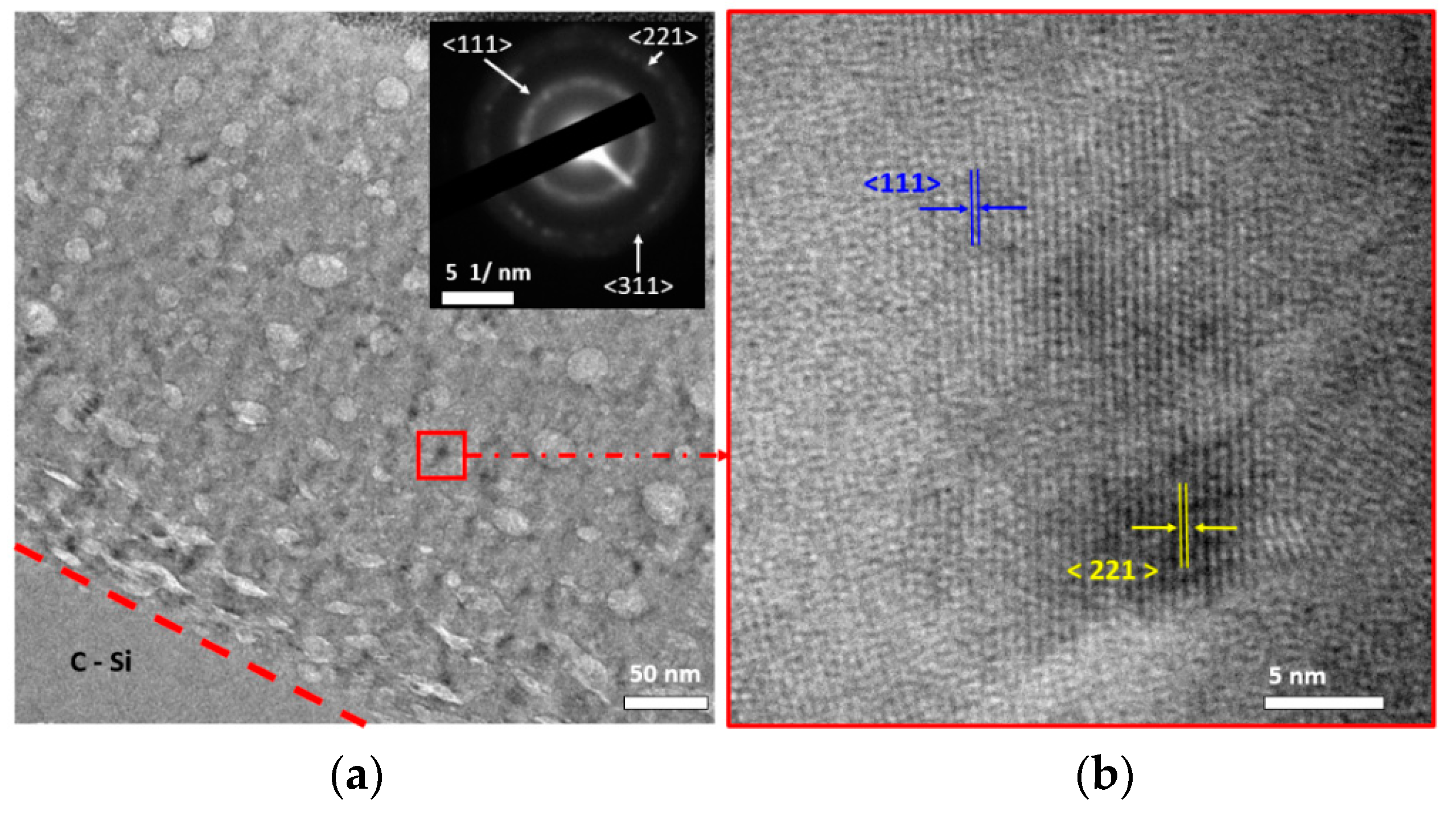
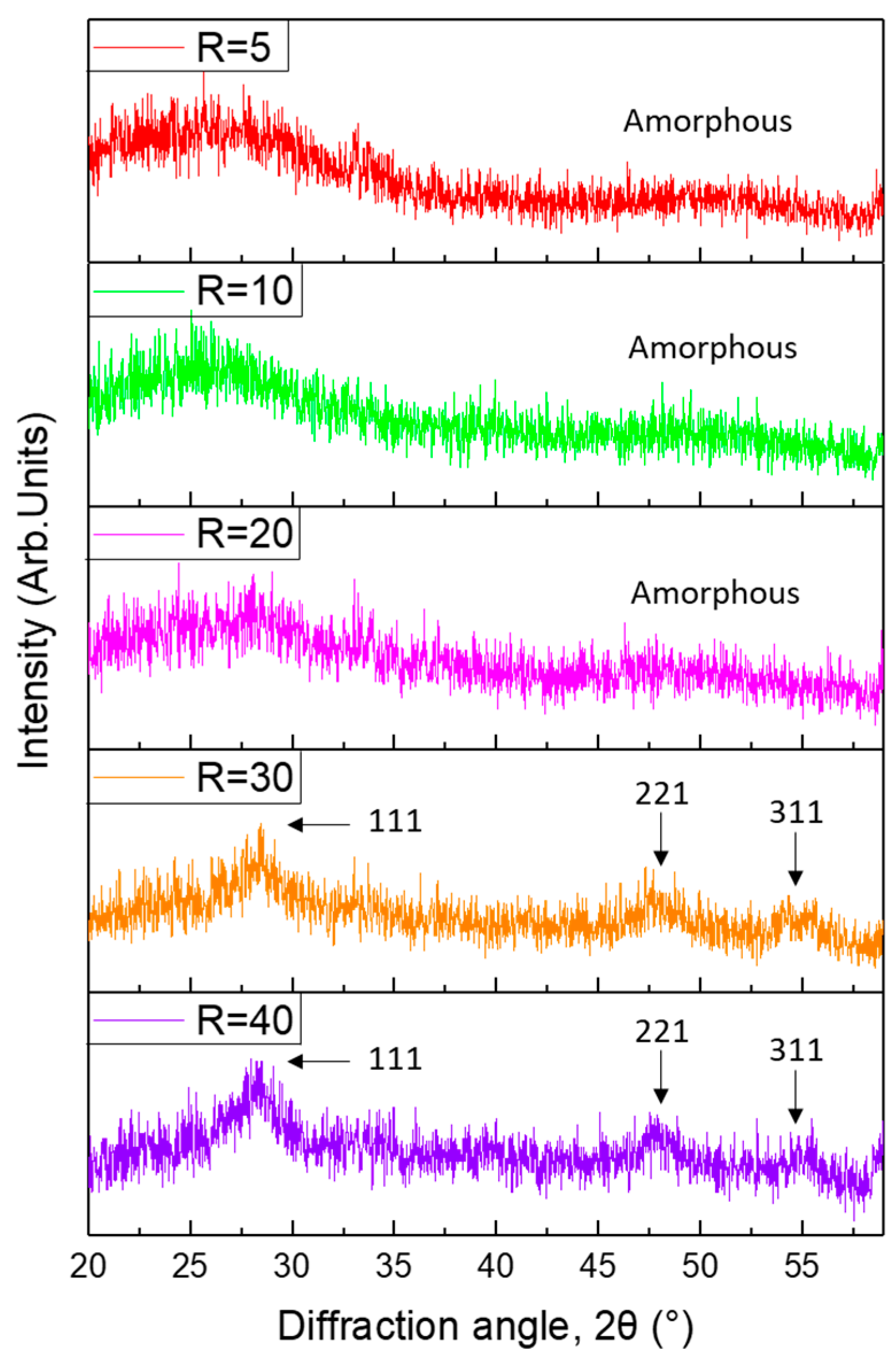
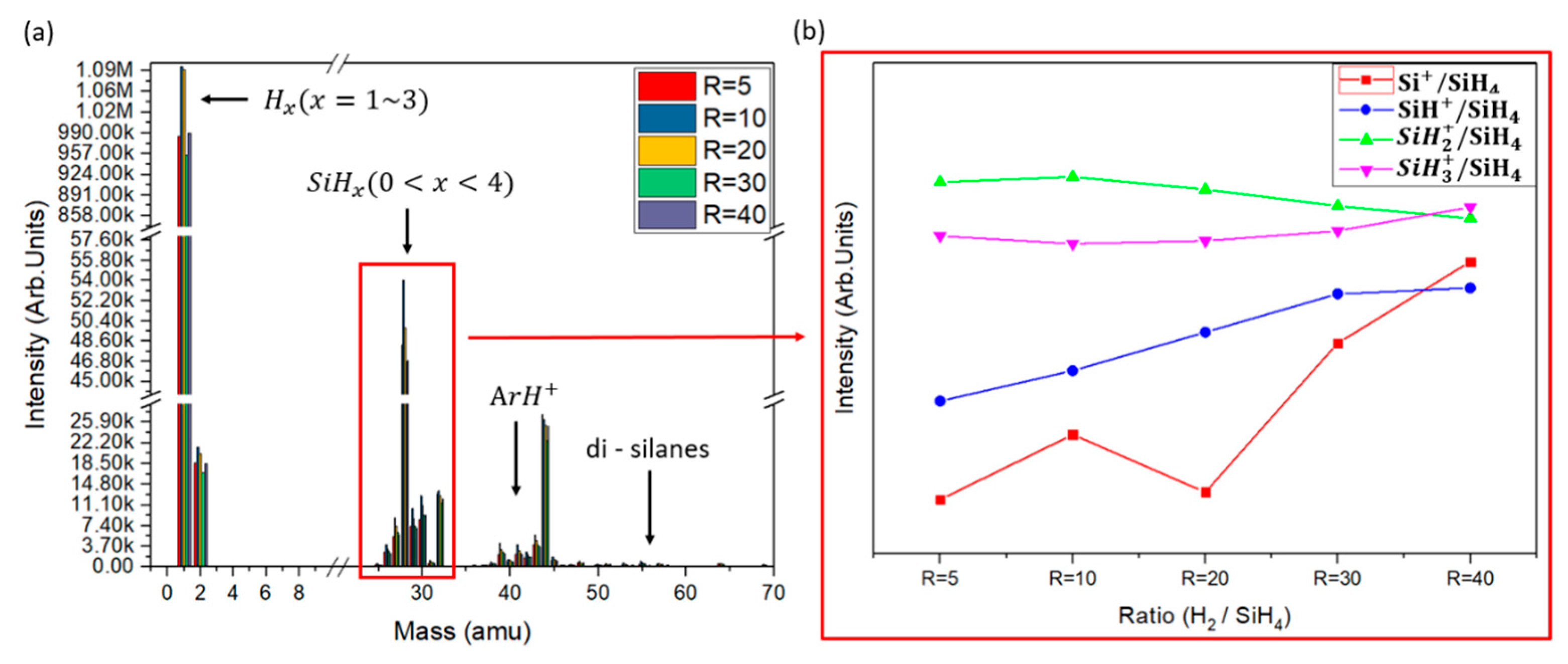
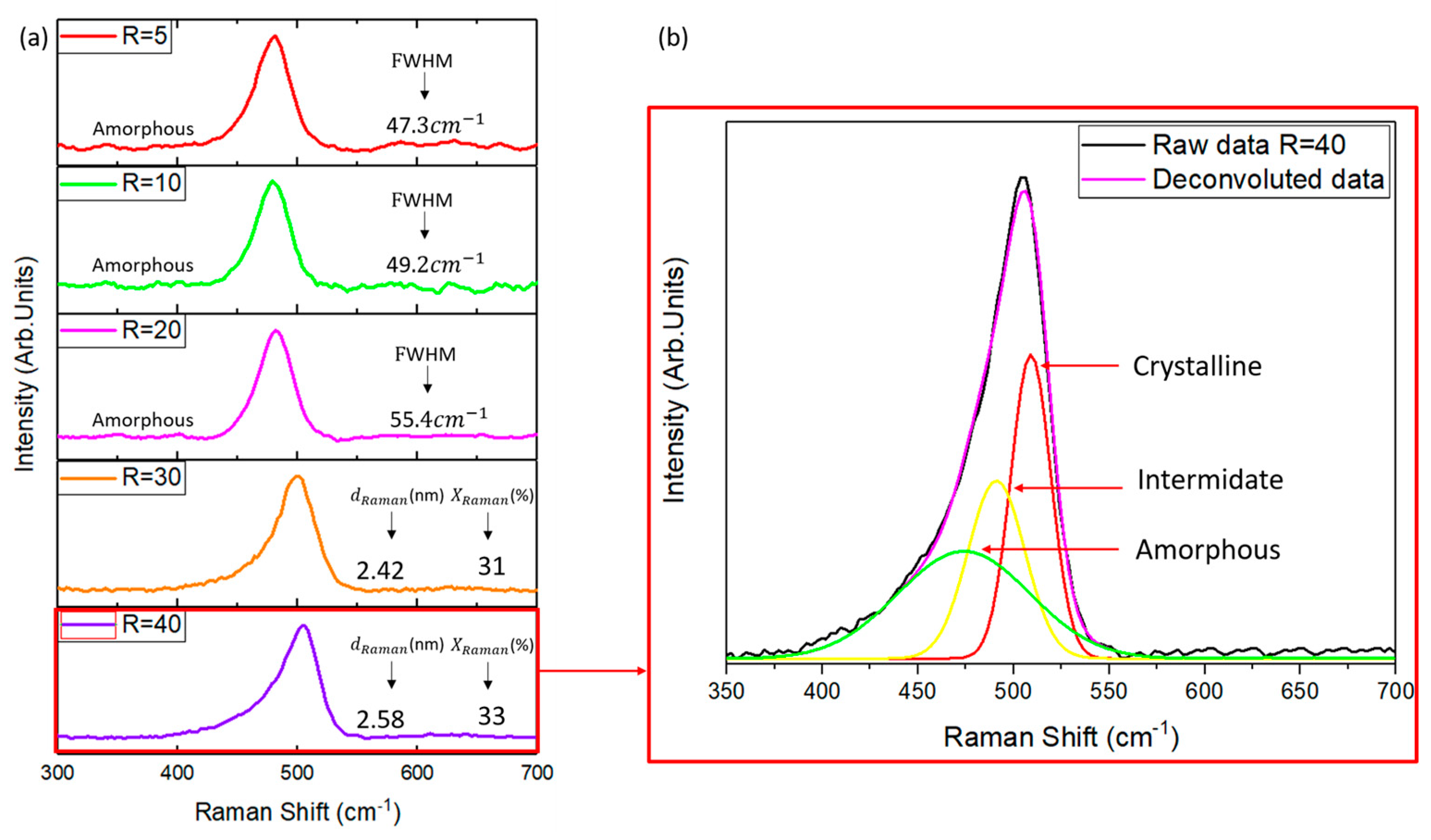
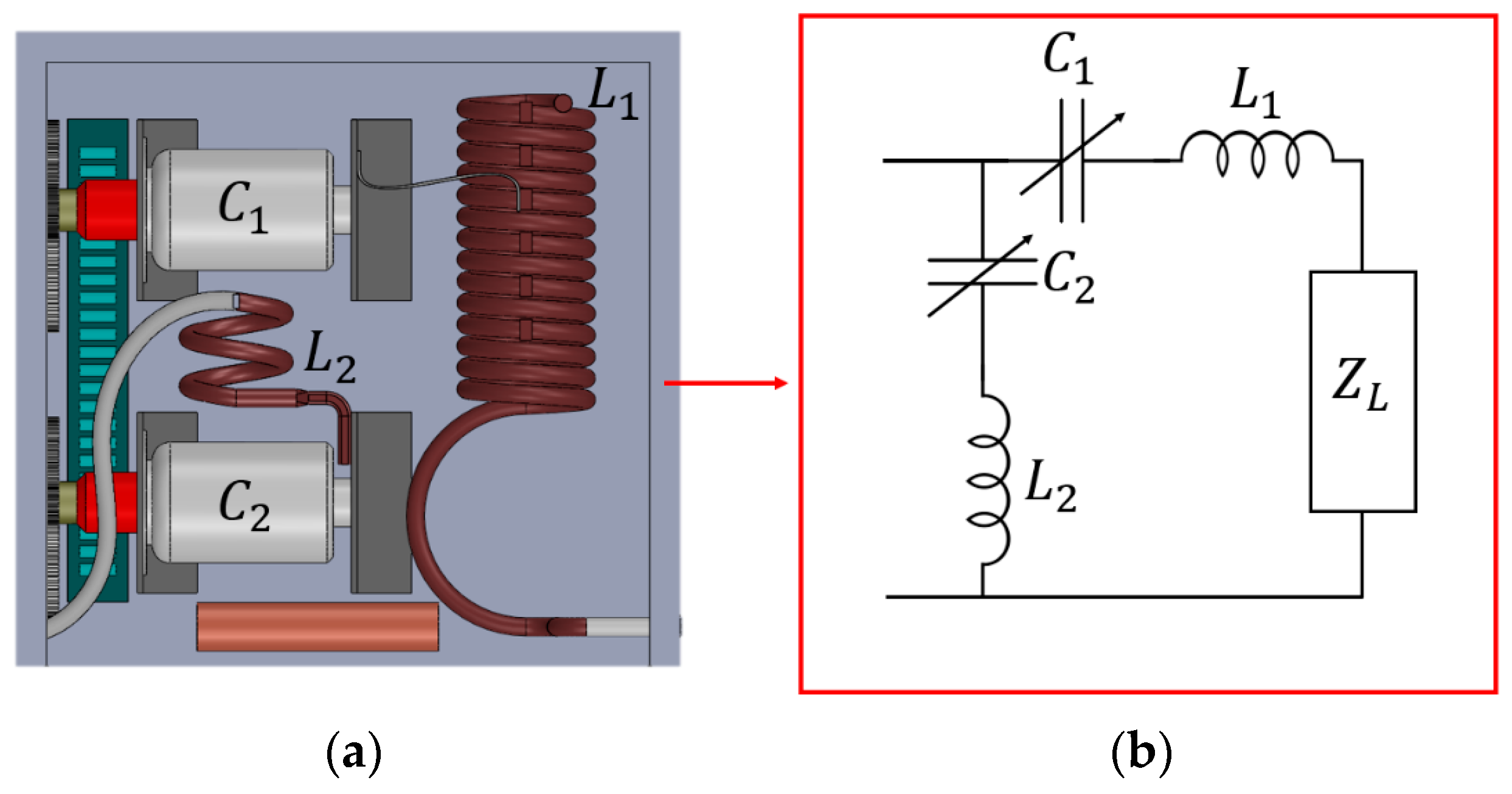
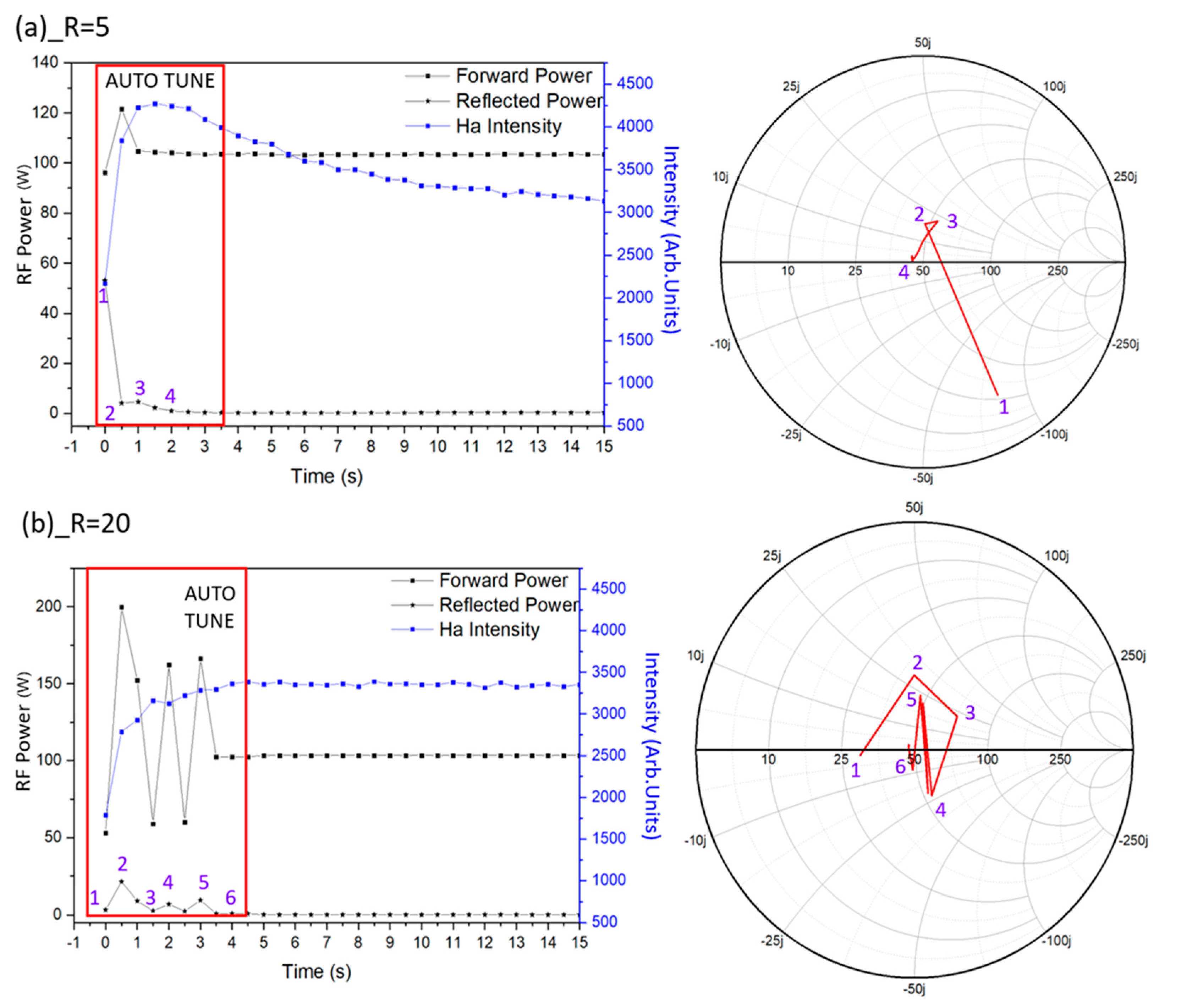


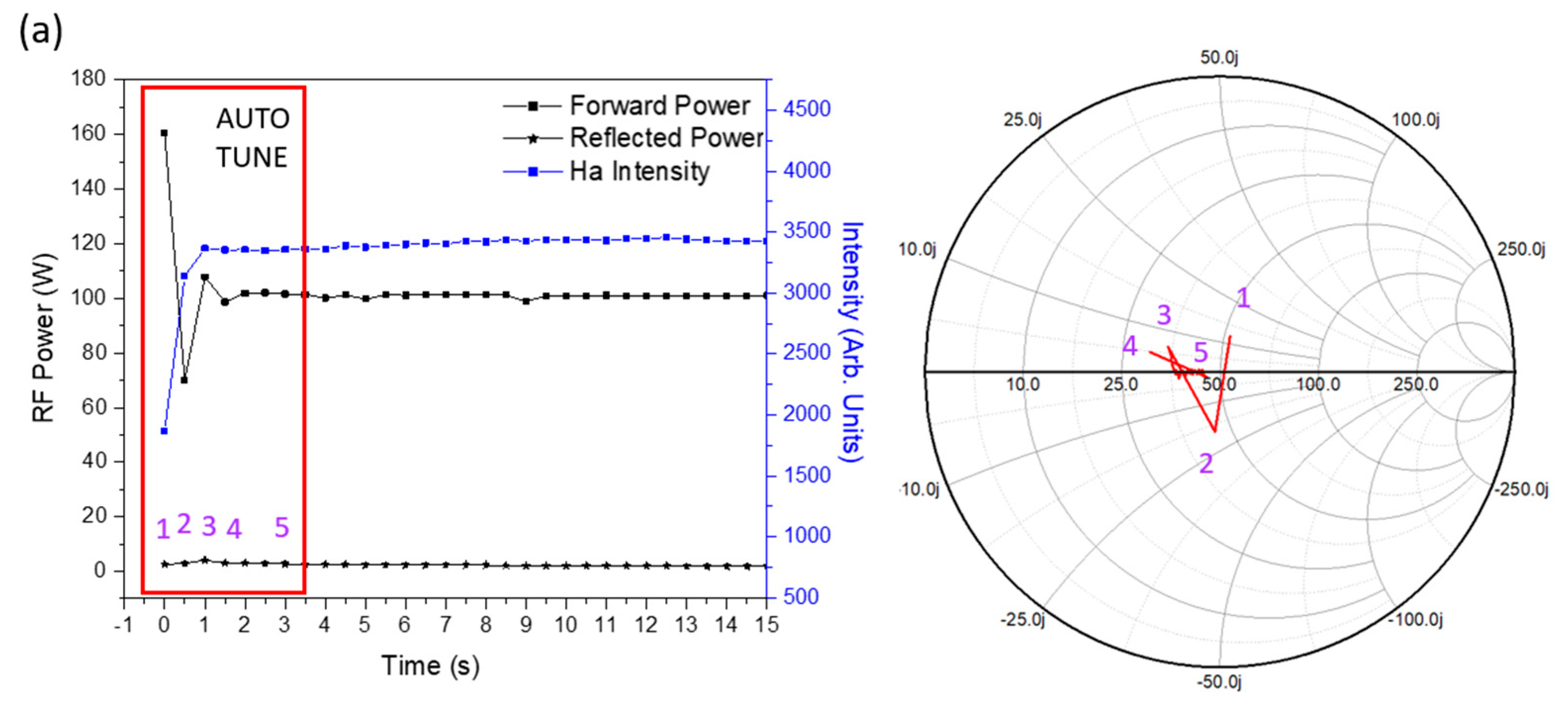
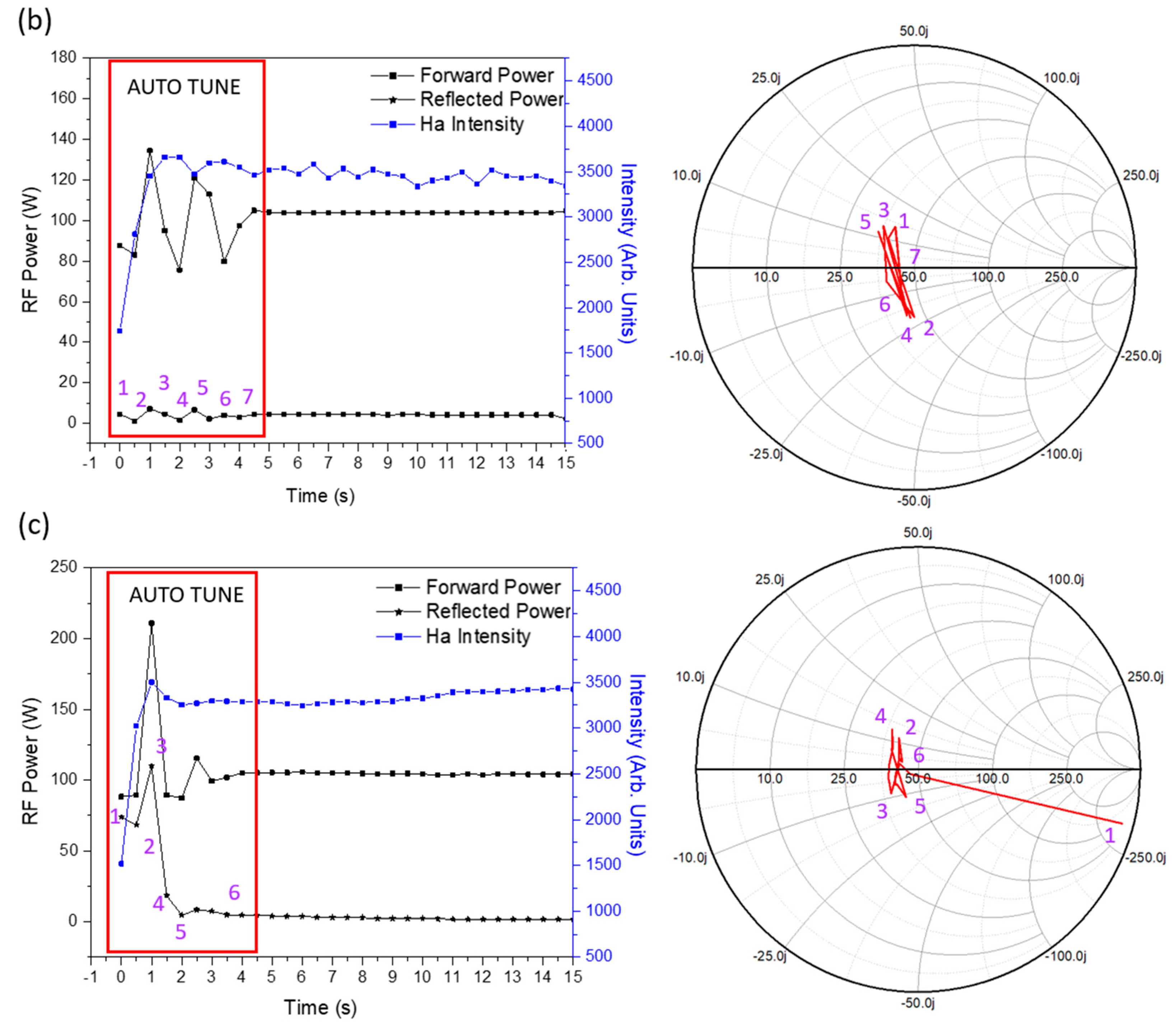
© 2019 by the authors. Licensee MDPI, Basel, Switzerland. This article is an open access article distributed under the terms and conditions of the Creative Commons Attribution (CC BY) license (http://creativecommons.org/licenses/by/4.0/).
Share and Cite
Kau, L.-H.; Huang, H.-J.; Chang, H.-E.; Hsieh, Y.-L.; Lee, C.-C.; Fuh, Y.-K.; Li, T.T. Correlation of Impedance Matching and Optical Emission Spectroscopy during Plasma-Enhanced Chemical Vapor Deposition of Nanocrystalline Silicon Thin Films. Coatings 2019, 9, 305. https://doi.org/10.3390/coatings9050305
Kau L-H, Huang H-J, Chang H-E, Hsieh Y-L, Lee C-C, Fuh Y-K, Li TT. Correlation of Impedance Matching and Optical Emission Spectroscopy during Plasma-Enhanced Chemical Vapor Deposition of Nanocrystalline Silicon Thin Films. Coatings. 2019; 9(5):305. https://doi.org/10.3390/coatings9050305
Chicago/Turabian StyleKau, Li-Han, Hung-Jui Huang, Hsueh-Er Chang, Yu-Lin Hsieh, Chien-Chieh Lee, Yiin-Kuen Fuh, and Tomi T. Li. 2019. "Correlation of Impedance Matching and Optical Emission Spectroscopy during Plasma-Enhanced Chemical Vapor Deposition of Nanocrystalline Silicon Thin Films" Coatings 9, no. 5: 305. https://doi.org/10.3390/coatings9050305
APA StyleKau, L.-H., Huang, H.-J., Chang, H.-E., Hsieh, Y.-L., Lee, C.-C., Fuh, Y.-K., & Li, T. T. (2019). Correlation of Impedance Matching and Optical Emission Spectroscopy during Plasma-Enhanced Chemical Vapor Deposition of Nanocrystalline Silicon Thin Films. Coatings, 9(5), 305. https://doi.org/10.3390/coatings9050305




